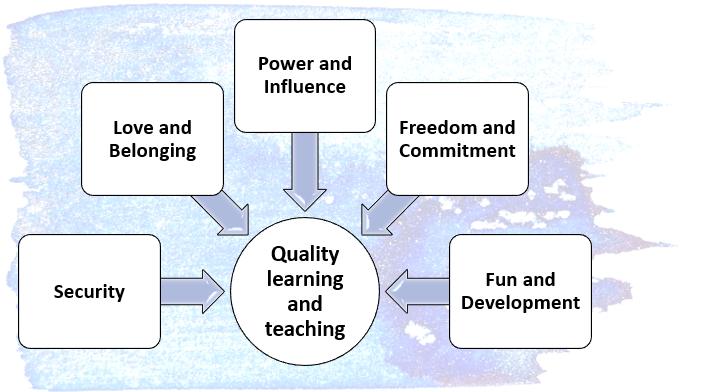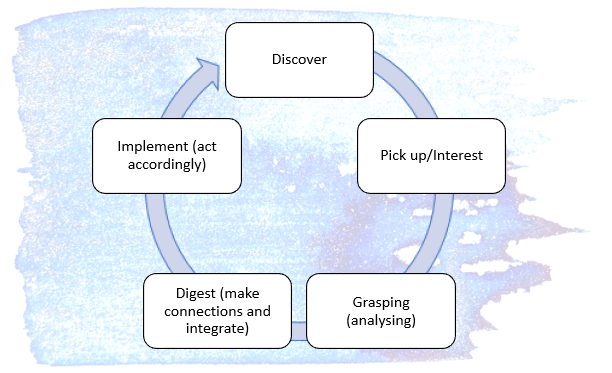17. How the consideration of the Five Basic Needs can find its way into everyday classroom life
The Five Basic Needs according to William Glasser represent a theory of motivation. Remember the beginning of this module. That was about the topic of motivation.
This section is about that again: If we again start from the assumption that ALL people have these basic needs and that basic needs motivate our actions, the question immediately arises how you as a teacher can take the Five Basic Needs into account in your everyday school life. Here is a brief compilation:
 Figure 17: Five Basic Needs in the classroom
Figure 17: Five Basic Needs in the classroom
Survival and security
Learning also means venturing out of the safety zone again and again, exploring, taking risks, exposing oneself, experimenting. Establish a culture in the classroom where seeking, trying out, exploring different perspectives and making mistakes are part of learning and where the strategy is questioned on a case-by-case basis, but never the person.
Love and belonging
People invest a lot to belong to a group and have a sense of community. The quality of relationships between young people and between students and teachers has a significant impact on motivation to learn and is an important factor in resilience.
Power and influence
Many "disruptive actions" in the classroom are due to individual students not being able to participate and contribute in a way that empowers and positively influences them. Therefore, it is important to create spaces where the different personalities in a class feel individually noticed and can contribute, e.g. through different learning settings. In case of disruptive behaviour of individual students, you can try to find out together with them with which behaviour they could get positive attention. The feeling of effectiveness and influence can be strengthened enormously through recognition, praise for partial successes and joint target agreements.
Freedom and commitment
Young people need the freedom to take responsibility for themselves. Making decisions also means bearing the consequences. If someone else made the decision, who bears the consequences? Therefore, it is important that pupils - according to their age - are trusted and expected to make a decision and take responsibility for it. In this way, young people learn to assess and expand their own abilities and limits.
To be able to accompany young people on their way to freedom and thus to maturity, an environment is needed in which making mistakes and making wrong decisions is seen as part of the learning and development process.
 A free decision results in commitment that is supported and nourished by inner motivation. This commitment in turn promotes the flow state, that state in which one can immerse oneself in an activity with one's entire personality and concentration.
A free decision results in commitment that is supported and nourished by inner motivation. This commitment in turn promotes the flow state, that state in which one can immerse oneself in an activity with one's entire personality and concentration.
Fun and development
School time falls at an age when children and young people are growing and developing. Therefore, they have a fundamental need for cognitive and social stimulation. In our information society, there is a certain degree of saturation, which is exacerbated by stimulus overload and the impossibility of implementing the resulting emotional and physical impulses.
In order to reawaken the desire to discover and absorb new things and to stimulate the need for growth, it is therefore important to provide learning opportunities that cover the entire cycle:
Discover - Absorb/Interest - Understand (Analyse) - Digest (Make Connections and Integrate) - Implement (Act Appropriately) and Conclude.
 Figure 18: Learning cycle
Figure 18: Learning cycle
Learning opportunities must also be diverse to address all types of learners in order to do justice to the mostly heterogeneous class structure.
In order to enable pupils to learn independently, they must not only learn to acquire important (learning) methods, but also to manage and control their own educational processes. This includes self- and time management as well as the ability of self-assessment. Individual learning guides in the upper school can help to improve learning methods and self-organisation skills that have not yet been optimised.